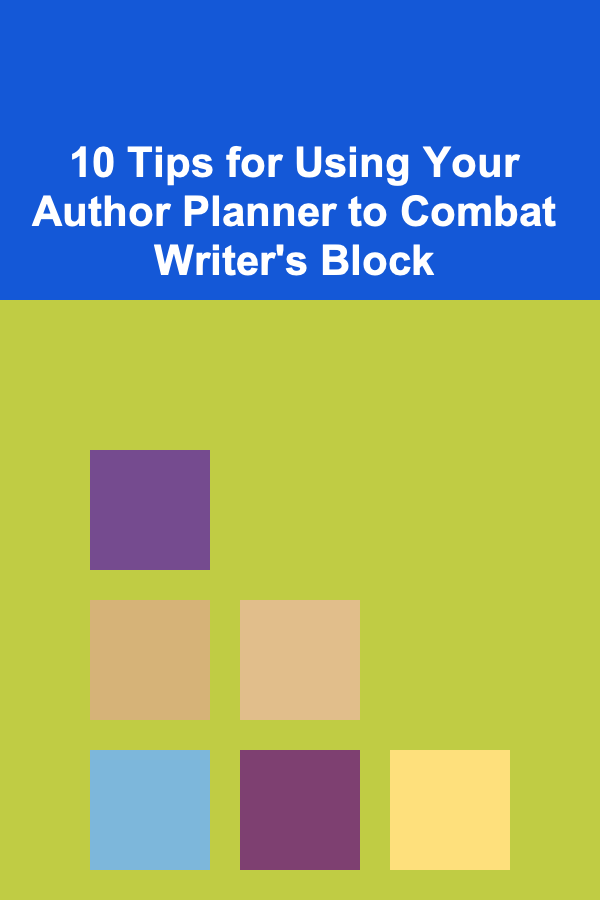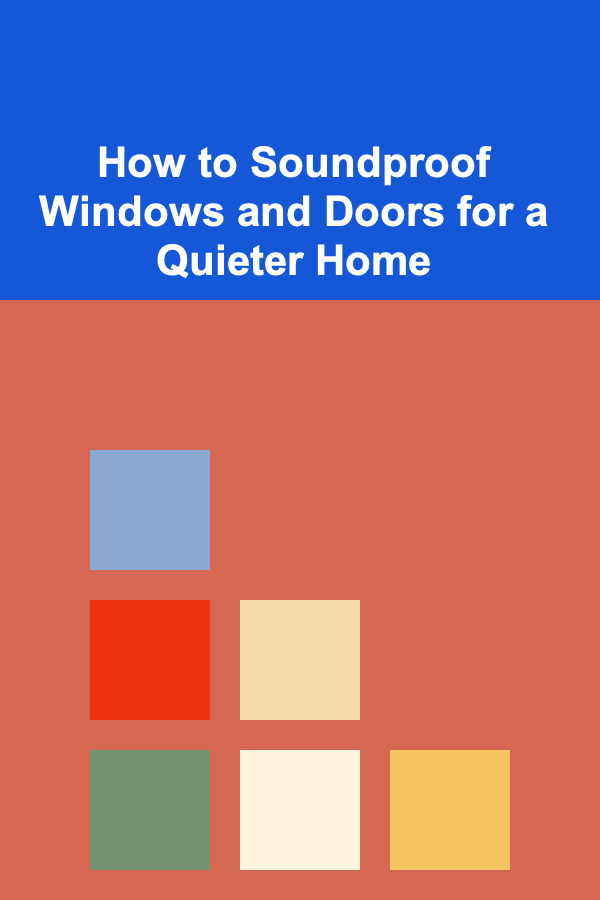
10 Tips for Using Your Author Planner to Combat Writer's Block
ebook include PDF & Audio bundle (Micro Guide)
$12.99$5.99
Limited Time Offer! Order within the next:

Writer's block is a challenge that every writer faces at some point, regardless of experience. It can feel like the words just won't come, the ideas dry up, or the creative spark is suddenly extinguished. For authors, whether seasoned or just starting out, finding a way to push through this mental barrier is key to continuing productivity and creative output. One of the most effective tools to combat writer's block is the Author Planner --- a personalized organizational tool that can help you structure your thoughts, set writing goals, and get back on track when you're feeling stuck.
In this article, we'll explore ten essential tips for using your Author Planner to overcome writer's block. By organizing your thoughts and structuring your writing process, you can regain control and continue your creative journey without losing momentum.
Set Clear Writing Goals with Your Planner
One of the main reasons writers experience blockages is the feeling of being overwhelmed by the enormity of the task ahead. Without clear, actionable goals, it's easy to feel lost in a sea of ideas, deadlines, and expectations. Your Author Planner can help break down this overwhelming process into manageable pieces by setting clear, achievable writing goals.
How to Use It:
- Daily Goals: Write down specific daily word count targets or the number of pages you want to complete each day. For example, aim for 500 words a day or one chapter per week. This gives you something concrete to work toward.
- Weekly Milestones: In addition to daily goals, set weekly milestones that align with your larger writing goals. For example, if you're working on a novel, aim to finish one draft chapter per week.
- Long-Term Goals: Your planner should include an overarching goal, like finishing the first draft by the end of the month or completing a manuscript by the year's end. This helps you keep sight of the bigger picture while working on the smaller tasks.
Why It Helps:
By breaking down your writing process into smaller, digestible chunks, you reduce the pressure and anxiety that can contribute to writer's block. The clear goals in your planner act as stepping stones, pushing you forward even on days when motivation is low.
Use Prompts and Exercises to Spark Ideas
When writer's block hits, it's often because you're struggling to find the next idea or piece of inspiration. Your Author Planner can serve as a repository of creative writing prompts, exercises, and ideas to reignite your imagination. These exercises don't have to be complex or directly related to your current project. Sometimes, a simple prompt can unlock the floodgates of creativity.
How to Use It:
- Write One Prompt a Day: Dedicate a section of your planner to creative prompts or free writing exercises. Even if you don't immediately use them in your main work, they can act as an effective warm-up.
- Character Development: If you're stuck in a story, use your planner to explore your characters' backstories or motivations. Create detailed profiles for each one, including their likes, dislikes, and fears.
- Free Writing: Write for ten to twenty minutes each day in your planner without worrying about structure or coherence. The goal is to let your mind wander and explore new ideas freely.
Why It Helps:
Using prompts and exercises helps you break the mental block by taking the pressure off perfection. You can simply write to write, and sometimes that's all it takes to get back in the flow.
Break Down the Writing Process into Manageable Tasks
Writer's block can be intensified when the writing process feels overwhelming. A novel, article, or any long-form piece of writing can seem like an insurmountable task. Your Author Planner allows you to break the writing process down into smaller, more manageable steps. Instead of focusing on finishing an entire manuscript, focus on completing smaller sections.
How to Use It:
- Outline Chapters or Sections: Write out an outline for your book or article, dividing it into clear sections or chapters. For each chapter, jot down key points or events that need to happen.
- Focus on One Section at a Time: Work on one section of the outline or one chapter per writing session. This approach removes the pressure of having to write everything at once.
Why It Helps:
By compartmentalizing the writing process, you shift the focus from the intimidating big picture to smaller, achievable tasks. This can help reduce anxiety and improve productivity, making it easier to get back into the groove.
Track Your Writing Habits
Understanding your own writing habits can be an invaluable tool for overcoming writer's block. Your Author Planner can serve as a journal to track when and how often you write, what time of day works best for you, and the conditions that help you feel most productive. This self-awareness can help you identify patterns that lead to successful writing sessions and avoid situations that hinder your creativity.
How to Use It:
- Track Writing Sessions: Record the time, duration, and word count for each writing session. Include notes on how you felt or what obstacles you encountered.
- Identify Patterns: Look for trends in your writing habits. Do you write best in the mornings? Do you feel more productive after a cup of coffee or a walk? Recognizing these patterns can help you structure your writing sessions more effectively.
Why It Helps:
Tracking your writing habits gives you actionable insights into what works for you. By making adjustments based on these insights, you can create an environment that fosters creativity and productivity.
Create a Daily Routine with Your Planner
One of the best ways to combat writer's block is by establishing a consistent writing routine. Writers often face blocks when they don't have a set schedule, leaving them prone to distractions or uncertainty. An Author Planner can help you establish a daily routine, making writing a regular part of your day rather than something you only do sporadically.
How to Use It:
- Set Specific Writing Times: Block off dedicated writing times in your planner each day. Treat these blocks like appointments or meetings that cannot be moved.
- Create Pre-Writing Rituals: Develop a routine before each writing session, such as reading for fifteen minutes, listening to music, or doing a short meditation. This helps signal to your brain that it's time to write.
Why It Helps:
A consistent writing schedule provides structure, making it easier to get started each day. Over time, this routine becomes a habit, helping to reduce writer's block as your brain becomes accustomed to a regular writing practice.
Use Visual Aids and Inspiration Boards
When words aren't flowing, visual aids can provide the spark you need. Your Author Planner can serve as a place to pin or sketch ideas, collect photos, and organize inspirational material related to your project. Visual inspiration can help break through the block by triggering new ideas or creative solutions.
How to Use It:
- Create Vision Boards: Dedicate a section of your planner to a vision board where you can pin images, quotes, and other visual elements that inspire you.
- Add Visual Prompts: Include sketches, maps, or diagrams related to your story. For example, if you're writing a fantasy novel, create a map of your world and refer to it when you need direction.
Why It Helps:
Visual aids tap into a different part of your brain, stimulating creativity in ways that words alone might not. By incorporating visuals into your planning process, you can unlock new ways to approach your writing and overcome mental blocks.
Celebrate Small Wins and Progress
Writer's block can feel insurmountable, but celebrating even small victories is key to maintaining momentum. When you record every achievement, whether it's completing a chapter or reaching a daily word count goal, your planner becomes a record of progress, not failure.
How to Use It:
- Track Milestones: In addition to daily and weekly goals, celebrate major milestones like finishing a chapter, completing a draft, or meeting your monthly word count target.
- Reward Yourself: Create rewards for yourself when you hit your goals. Treat yourself to something special, like a break or a favorite snack, when you reach a writing milestone.
Why It Helps:
Celebrating progress, no matter how small, boosts morale and motivates you to keep going. Positive reinforcement helps break through mental barriers and encourages continued effort.
Stay Accountable with Writing Challenges
Sometimes, a bit of external motivation can help get you back on track when writer's block strikes. Your Author Planner can be used to keep track of writing challenges, either self-imposed or part of a larger writing group or community.
How to Use It:
- Join Writing Challenges: Participate in challenges like NaNoWriMo (National Novel Writing Month) or create your own 30-day writing challenge with specific goals.
- Set Accountability Check-ins: Include regular check-ins with a writing partner or group in your planner. Accountability can push you to write even when the creative well feels dry.
Why It Helps:
Writing challenges add an element of fun and urgency to the process, making it easier to focus and push through the tough moments. The external accountability encourages commitment and persistence.
Reflect and Adjust Your Approach
Sometimes writer's block happens because the approach you're using isn't working. Instead of stubbornly pushing through, take a step back and use your planner to reflect on what's not working and how you can adjust. This could mean changing your writing environment, switching genres, or adjusting your goals.
How to Use It:
- Reflect on What's Not Working: In your planner, take time to jot down what's causing the block. Is it your plot, characters, or writing space?
- Adjust Goals and Strategy: Once you've reflected, change your approach. If your current goals feel too ambitious, scale them back. If your environment is stifling creativity, try a new location.
Why It Helps:
Reflection and adjustment help you shift gears when necessary. Sometimes, stepping away from a problem or project can provide the clarity needed to move forward.
Keep Writing, Even If It's Not Perfect
Finally, one of the best ways to combat writer's block is simply to keep writing. Perfectionism often fuels writer's block, so using your Author Planner as a tool to remind yourself that it's okay to write imperfectly can be incredibly freeing.
How to Use It:
- Set "Imperfect Writing" Days: In your planner, designate days when you allow yourself to write freely without worrying about grammar, structure, or plot. Just focus on getting words on the page.
- Write Anything: On tough days, commit to writing something, even if it's not related to your current project. A short story, journal entry, or scene will keep the creative muscles moving.
Why It Helps:
By allowing yourself to write without the pressure of perfection, you free yourself from the grip of writer's block. Writing imperfectly gives you the freedom to create, even when you're not feeling inspired.
Conclusion
Writer's block can be frustrating, but it's not an insurmountable obstacle. By using your Author Planner effectively, you can structure your writing process, set achievable goals, and incorporate strategies to overcome the challenges that block your creativity. The key is to stay organized, stay motivated, and embrace the idea that writing is a process --- not a perfect, linear path. With the right tools and mindset, you can keep your creative juices flowing and continue writing your best work, no matter what.
Reading More From Our Other Websites
- [Home Rental Property 101] How to Find Houses for Rent Near Public Transit for Easy Commuting
- [Home Maintenance 101] How to Keep Your Air Conditioning System in Top Shape
- [Home Party Planning 101] How to Throw a Memorable New Year's Eve Party at Home
- [Organization Tip 101] The Best Drip Irrigation System Kits for Home Gardeners
- [Mindful Eating Tip 101] Mindful Meal Prep: Crafting Plant-Based Dishes with Intention and Joy
- [Personal Financial Planning 101] How to Turn Your Skills and Hobbies Into Passive Income Ideas
- [Home Holiday Decoration 101] How to Incorporate Natural Elements into Your Holiday Decorations
- [Trail Running Tip 101] Trail Running Together: A Beginner's Guide for the Whole Family
- [Home Family Activity 101] How to Organize Backyard Sports Games for Family Fun
- [Personal Investment 101] How to Use Deep Learning to Develop High-Demand AI Products

Essential Guide to Creating and Sticking to a Monthly Budget for Financial Success
Read More
How to Optimize Vertical Space in a Small Craft Area
Read More
How to Soundproof Windows and Doors for a Quieter Home
Read More
How to Start a Profitable Website Design Side Business from Home
Read More
How to Store Seasonal Decor Without Taking Up Too Much Space
Read More
How to Plan a Product Launch with Limited Budget
Read MoreOther Products

Essential Guide to Creating and Sticking to a Monthly Budget for Financial Success
Read More
How to Optimize Vertical Space in a Small Craft Area
Read More
How to Soundproof Windows and Doors for a Quieter Home
Read More
How to Start a Profitable Website Design Side Business from Home
Read More
How to Store Seasonal Decor Without Taking Up Too Much Space
Read More